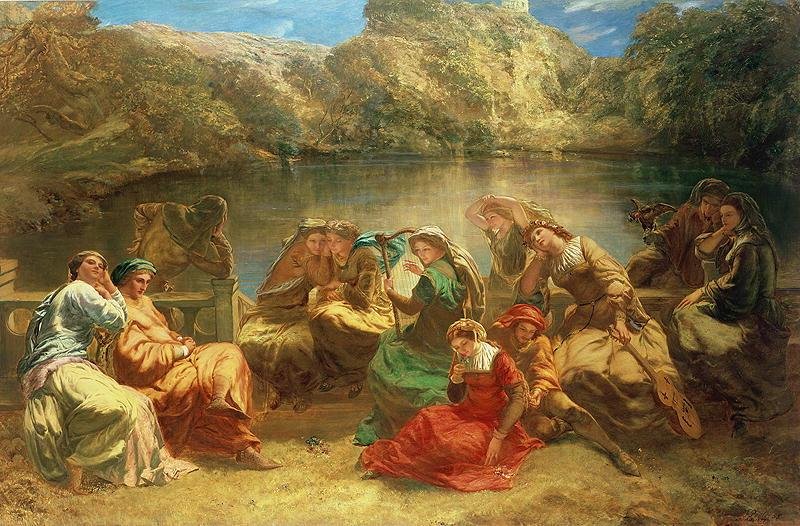-
Paul Falconer Poole’s: The Seventh Day of The Decameron
Introduction
Geoffrey Chaucer's "The Miller's Tale," a comedic masterpiece, showcases his unique storytelling style, diverging from the direct influence of Boccaccio's Decameron while still drawing inspiration from its narrative structure. Unlike Boccaccio, who explicitly highlights the laughter elicited by his tales, Chaucer subtly weaves humor into the very fabric of his narrative, culminating in a ludicrous and unexpected conclusion. The characters – the cunning Nicholas, the gullible John, the alluring Alisoun, and the hapless Absalon – are all cleverly mocked, amplifying the tale's comedic effect. The low social standing of the characters further contributes to the story's overall farcical tone.
Summary
"The Miller's Tale" revolves around a series of deceptions and pranks involving a carpenter, his young wife, a student, and a parish clerk. Nicholas, a clever student, convinces John, the carpenter, that a great flood is imminent. He then uses this ruse to seduce John's wife, Alisoun. Absalon, the lovestruck parish clerk, attempts to kiss Alisoun, but is tricked by Nicholas, who substitutes his backside for Alisoun's face. The tale concludes with Absalon's humiliation and the audience's amusement at the characters' misfortunes. The narrative skillfully interweaves the characters' actions, creating a chain of events that results in a humorous and unexpected resolution.
Analysis
Chaucer's approach differs significantly from Boccaccio's. Boccaccio explicitly states the audience's reactions to his stories, emphasizing the laughter they provoked. Chaucer, however, integrates the humor directly into the narrative, relying on the absurdity of the situations and the characters' reactions to generate comedic effect. The use of the flood motif is particularly clever, serving as a catalyst for the ensuing events and ultimately contributing to the ironic resolution. The tale's success lies in its skillful interweaving of plot elements, leading to a satisfyingly chaotic conclusion.
Personal Response
Chaucer's masterful storytelling in "The Miller's Tale" is captivating. The characters are vividly portrayed, their flaws and desires contributing to the overall comedic effect. The unexpected twists and turns maintain the reader's engagement, culminating in a satisfyingly ludicrous ending. The tale’s humor isn’t merely slapstick; it’s a sophisticated blend of irony, wit, and social commentary, making it both entertaining and thought-provoking. The story’s ability to elicit laughter while also subtly critiquing societal norms is a testament to Chaucer's skill as a writer.
Conclusion
While Chaucer may have been influenced by Boccaccio's Decameron, "The Miller's Tale" demonstrates his unique narrative voice and comedic genius. His approach to storytelling, characterized by subtle humor, skillfully interwoven plot elements, and memorable characters, sets his work apart. The tale's lasting appeal lies in its ability to entertain and provoke thought, solidifying Chaucer's position as a master storyteller and a significant figure in English literature. The absence of explicit audience reaction descriptions, unlike Boccaccio's brigata, underscores Chaucer's reliance on implicit humor and the inherent comedic nature of the narrative itself.
Paul Falconer Poole’s: The Seventh Day of The Decameron Introduction Geoffrey Chaucer's "The Miller's Tale," a comedic masterpiece, showcases his unique storytelling style, diverging from the direct influence of Boccaccio's Decameron while still drawing inspiration from its narrative structure. Unlike Boccaccio, who explicitly highlights the laughter elicited by his tales, Chaucer subtly weaves humor into the very fabric of his narrative, culminating in a ludicrous and unexpected conclusion. The characters – the cunning Nicholas, the gullible John, the alluring Alisoun, and the hapless Absalon – are all cleverly mocked, amplifying the tale's comedic effect. The low social standing of the characters further contributes to the story's overall farcical tone. Summary "The Miller's Tale" revolves around a series of deceptions and pranks involving a carpenter, his young wife, a student, and a parish clerk. Nicholas, a clever student, convinces John, the carpenter, that a great flood is imminent. He then uses this ruse to seduce John's wife, Alisoun. Absalon, the lovestruck parish clerk, attempts to kiss Alisoun, but is tricked by Nicholas, who substitutes his backside for Alisoun's face. The tale concludes with Absalon's humiliation and the audience's amusement at the characters' misfortunes. The narrative skillfully interweaves the characters' actions, creating a chain of events that results in a humorous and unexpected resolution. Analysis Chaucer's approach differs significantly from Boccaccio's. Boccaccio explicitly states the audience's reactions to his stories, emphasizing the laughter they provoked. Chaucer, however, integrates the humor directly into the narrative, relying on the absurdity of the situations and the characters' reactions to generate comedic effect. The use of the flood motif is particularly clever, serving as a catalyst for the ensuing events and ultimately contributing to the ironic resolution. The tale's success lies in its skillful interweaving of plot elements, leading to a satisfyingly chaotic conclusion. Personal Response Chaucer's masterful storytelling in "The Miller's Tale" is captivating. The characters are vividly portrayed, their flaws and desires contributing to the overall comedic effect. The unexpected twists and turns maintain the reader's engagement, culminating in a satisfyingly ludicrous ending. The tale’s humor isn’t merely slapstick; it’s a sophisticated blend of irony, wit, and social commentary, making it both entertaining and thought-provoking. The story’s ability to elicit laughter while also subtly critiquing societal norms is a testament to Chaucer's skill as a writer. Conclusion While Chaucer may have been influenced by Boccaccio's Decameron, "The Miller's Tale" demonstrates his unique narrative voice and comedic genius. His approach to storytelling, characterized by subtle humor, skillfully interwoven plot elements, and memorable characters, sets his work apart. The tale's lasting appeal lies in its ability to entertain and provoke thought, solidifying Chaucer's position as a master storyteller and a significant figure in English literature. The absence of explicit audience reaction descriptions, unlike Boccaccio's brigata, underscores Chaucer's reliance on implicit humor and the inherent comedic nature of the narrative itself.0 Reacties ·0 aandelen ·892 Views ·0 voorbeeld
Meer blogs




